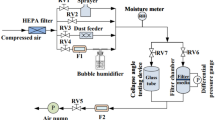Abstract
IN his recent letter Dr. Wigglesworth1 has explained the desiccating action of inert dusts on insects by the abrasion and perhaps adsorption of waxy substances forming a thin layer on the cuticle. The following results, which appear to confirm his conclusions, were obtained while comparing the dust resistances of various races and species of Drosophila, and spraying dust on some other animals. Of the various dusts tested, the loss of water was most accelerated by shaking the insects with charcoal of plant or animal origin. At 25° C. and 40–50 per cent relative humidity, Drosophila melanogaster flies were dead after eleven minutes, and D. subobscura after nine minutes, whereas in an atmosphere saturated with moisture, they survived for many hours. Mosquitoes, house-flies and house-spiders dusted with charcoal and kept in a centrally heated room died in less than an hour, and a young newt died in about two hours. Earthworms and slugs, on the other hand, were not killed by the dusts.
This is a preview of subscription content, access via your institution
Access options
Subscribe to this journal
Receive 51 print issues and online access
$199.00 per year
only $3.90 per issue
Buy this article
- Purchase on Springer Link
- Instant access to full article PDF
Prices may be subject to local taxes which are calculated during checkout
Similar content being viewed by others
References
Wigglesworth, V. B., NATURE, 153, 493 (1944).
Author information
Authors and Affiliations
Rights and permissions
About this article
Cite this article
KALMUS, H. Action of Inert Dusts on Insects. Nature 153, 714–715 (1944). https://doi.org/10.1038/153714a0
Issue Date:
DOI: https://doi.org/10.1038/153714a0
This article is cited by
-
Abrasion of Soil Insects
Nature (1944)
Comments
By submitting a comment you agree to abide by our Terms and Community Guidelines. If you find something abusive or that does not comply with our terms or guidelines please flag it as inappropriate.



